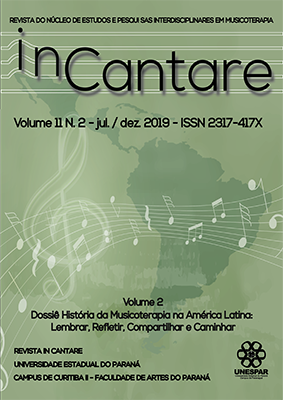Musicoterapia en la Neurorehabilitación de Adultos: Potenciales y Desafíos de la Práctica Clínica
DOI:
https://doi.org/10.33871/2317417X.2019.11.2.3486Resumo
La musicoterapia basada en evidencias neurocientíficas se ha consolidado como un abordaje válido y cada vez más solicitado en el ámbito médico. Específicamente en la neurorehabilitación de adultos con trastornos neurológicos y lesiones cerebrales adquiridas, las Neurociencias y la Musicoterapia comparten el común interés en la neuroplasticidad y los efectos terapéuticos de la música sobre la funcionalidad e independencia de la persona. La creciente demanda laboral de la musicoterapia en equipos e instituciones laborales representan oportunidades, como también desafíos para nuestra profesión. Este artículo ofrece una revisión y reflexión acerca de la práctica clínica musicoterapéutica en el ámbito de la neurorehabilitación de adultos, incluyendo el tratamiento del funcionamiento motriz, cognitivo, comunicativo y socioafectivo. Los nuevos avances, los potenciales y desafíos de la articulación de las neurociencias y la musicoterapia serán punto de exploración en este artículo, siempre delineados desde la perspectiva de una profesional musicoterapéuta clínica, investigadora y docente.
Downloads
Referências
Alashram, A., Annino, G. & Mercuri, N. (2019). Rhythmic Auditory Stimulation in Gait Rehabilitation for Traumatic Brain and Spinal Cord Injury. Journal of Clinical Neuroscience, 69. doi:10.1016/j.jocn.2019.08.080.
Alexomanolaki, M., Loveday, C., & Kennett, C. (2007). Music and Memory in Advertising : Music as a Device of Implicit Learning and Recall . Music, Sound, and the Moving Image. doi.org/10.3828/msmi.1.1.7
Altenmüller, E., & Schlaug, G. (2015). Apollo"™s gift: New aspects of neurologic music therapy. In Progress in Brain Research. doi.org/10.1016/bs.pbr.2014.11.029
Baird, A. & Samson, S. (2014) Music evoked autobiographical memory after severe acquired brain injury: Preliminary findings from a case series, Neuropsychological Rehabilitation, 24(1), 125-143, doi.org/10.1080/09602011.2013.858642
Bartz, J., Zaki, J., Bolger, N. & Ochsner, Kevin. (2011). Social effects of oxytocin in humans context and person matter. Trends Cogn Sci, 15, 301-309. doi.org/10.1016/j.tics.2011.05.002.
Bashwiner, D., Wertz, C., Flores, R. et al. Musical Creativity "Revealed" in Brain Structure: Interplay between Motor, Default Mode and Limbic Networks. Sci Rep, 6. doi.org/10.1038/srep20482
Codrons, E., Bernardi, N. F., Vandoni, M., & Bernardi, L. (2014). Spontaneous group synchronization of movements and respiratory rhythms. PloS one, 9(9), e107538. doi.org/10.1371/journal.pone.0107538
Fancourt, D., Ockelford, A., and Belai, A. (2014). The psychoneuroimmunological effects of music: A systematic review and a new model. Brain Behav. Immun. 36, 15–26. doi.org/10.1016/j.bbi.2013.10.014
Fusar-Poli, L., Bieleninik, Å., Brondino, N., Chen, X. J., & Gold, C. (2018). The effect of music therapy on cognitive functions in patients with dementia: a systematic review and meta-analysis. Aging and Mental Health. doi.org/10.1080/13607863.2017.1348474
Jeong, E., & Ryu, H. (2016). Nonverbal auditory working memory: Can music indicate the capacity? Brain and Cognition, 105, 9–21. doi.org/10.1016/j.bandc.2016.03.003
Koelsch, S., & Jäncke, L. (2015). Music and the heart. European heart journal,(36), 3043-3048. doi.org/10.1093/eurheartj/ehv430
Koelsch, S. (2019). Good Vibrations. Die Heileinde Kraft der Musik. Ullstein Buchverlag GmbH, SBN: 9783550050527
Magee, W. L., Clark, I., Tamplin, J., & Bradt, J. (2017). Music interventions for acquired brain injury. The Cochrane database of systematic reviews, 1(1), CD006787. https://doi.org/10.1002/14651858.CD006787.pub
Mainka, S., Wissel, J., Völler, H., & Evers, S. (2018). The Use of Rhythmic Auditory Stimulation to Optimize Treadmill Training for Stroke Patients: A Randomized Controlled Trial. Frontiers in neurology, 9, 755. doi.org/10.3389/fneur.2018.00755
Nayak, S., Wheeler, B., Shiflett, S. & Agostinelli, S. (2000). Effect of music therapy on mood and social interaction among individuals with acute traumatic brain injury and stroke. Rehabilitation Psychology (45), 274-283. doi.org/10.1037/0090-5550.45.3.274.
Peretz, I., Vuvan, D., Lagrois, M. É., & Armony, J. L. (2015). Neural overlap in processing music and speech. Philosophical transactions of the Royal Society of London. Series B, Biological sciences, 370(1664), 20140090. doi.org/10.1098/rstb.2014.0090
Pfeiffer, C. & Zamani, C. (2017). Explorando el cerebro musical: musicoterapia, música y neurociencias. Editorial Kier, ISBN: 978-84-17581-63-3
Särkämö, T., Tervaniemi, M., Laitinen, S., Forsblom, A., et al. (2008). Music listening enhances cognitive recovery and mood after middle cerebral artery stroke, Brain,131(3), 866–876, doi.org/10.1093/brain/awn013
Schlaug, G., Norton, A., Marchina, S., Zipse, L., & Wan, C. Y. (2010). From singing to speaking: Facilitating recovery from nonfluent aphasia. Future Neurology. doi.org/10.2217/fnl.10.44
Stegemöller, E.L. (2014) Exploring a Neuroplasticity Model of Music Therapy, Journal of Music Therapy, 51 (3), 211–227, doi.org/10.1093/jmt/thu023
Tamplin, J. (2015). Music therapy for adults with traumatic brain injury and other neurological disorders. In: Wheeler, B.L. (2015). Music Therapy Handbook. Guilford Press, USA. ISBN: 9781462529728
Taylor, D. (2010). Biomedical Foundations of Music as Therapy. Barton Publications, Eau Claire, Wisconsin.
Thaut, M. H., & Hoemberg, V. (2014). Handbook of neurologic music therapy. New York, NY : Oxford University Press. ISBN: 9780198792611
Thaut, M.H., Gardiner, J.C., Holmberg, D., Horwitz, J., Andrews, G., et al. (2009). Neurologic music therapy improves executive functioning and emotional adjustment in traumatic brain injury rehabilitation. Annals of New York Academy of Sciences, 1169, 406-416. doi.org/10.1111/j.1749-6632.2009.04585.x.
Thaut, M.H. (2015). Neurobiological Foundations of Neurologic Music Therapy: Rhythmic Entrainment and the Motor System. Frontiers in Psychology, 6. doi.org/ 10.3389/fpsyg.2014.01185.
Tomaino, C. (2012). Effective music therapy techniques in the treatment of nonfluent aphasia. Annals of the New York Academy of Sciences, 1252(1), 312-317. doi.org/10.1111/j.1749-6632.2012.06451.x.
Tong, Y., Forreider, B. Sun, X., Geng, X., Zhang, W., Du, H, Zhang, T. & Ding, Y. (2015) Music-supported therapy (MST) in improving post-stroke patients' upper-limb motor function: a randomised controlled pilot study, Neurological Research, 37(5), 434-440. doi.org/10.1179/1743132815Y.0000000034.
Van der Meulen, I., Van de Sandt-Koenderman, M., Heijenbrok-Kal, M., Visch-Brink, E. & Ribbers, G. (2014). The Efficacy and Timing of Melodic Intonation Therapy in Subacute Aphasia. Neurorehabilitation and neural repair, 28(6), 536-544. doi.org/ 10.1177/1545968313517753.
Weintraub, A., Ketchum, J., Hays, K., Kowalski, R. & Thompson, Sarah. (2018). Rhythmic Auditory Stimulation and Gait Training. In: Traumatic Brain Injury: A Feasibility Study. Archives of Physical Medicine and Rehabilitation, 98(10), e:176.
doi: 10.1016/j.apmr.2018.08.148.
Witek, M. A., Clarke, E. F., Wallentin, M., Kringelbach, M. L., & Vuust, P. (2014). Syncopation, body-movement and pleasure in groove music. PloS one, 9(4), e94446. doi.org/10.1371/journal.pone.0094446
Wheeler, B. (2015). Music Therapy Handbook. Guilford Press, New York. ISBN: 9781462529728





